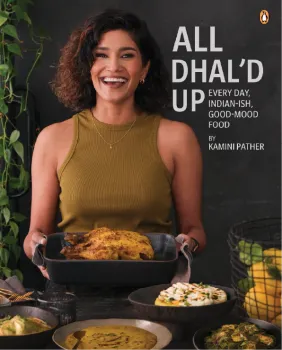Kamini Pather on cooking, culture and her new cookbook

Kamini Pather's All Dhal'd Up.
Image: supplied
Nutritionist, food blogger and MasterChef South Africa winner Kamini Pather has released a cookbook, All Dhal'd Up. She chats to us about the inspiration for the book.
Q. We first got to know you on MasterChef, and then on Netflix with Girl Eat World. You entered the food media industry as a nutritionist. Could you tell us a little about your background before all of that? What was it that initially inspired you to choose food as a career?
A. I entered the industry as an amateur cook who won season two of MasterChef SA. MasterChef is an amateur cooking competition that I entered as a food blogger. My dream was to work in food media and a blog offered me a space to be able to showcase my photography, writing and recipe creation skills. I would be tenacious (potentially annoying) at events where I would introduce myself to food editors and anyone with ears, really, and invite them to read my blog. I loved the words used to describe food and I would buy food magazines with my student budget and then copy the contact details onto my phone, as well as the blurb that was written about the food.
I come from a long line of cooks on both maternal and paternal sides, so being in the kitchen was always part of my life, even though I only started to cook much later in my life.
My first degree was in commerce and it wasn’t creative enough for me, so I started messing around in the kitchen with eggs.
Food made me feel creative, I always liken a blank canvas to an empty plate – the possibilities are endless.
I also grew up watching food TV. I loved Nigella Lawson’s coy but elegantly smutty take on a dish and Jamie Oliver’s lisp as he man-handled the pasta.
I would attend every single Good Food and Wine Show and meet my heroes that I’d watched on TV like Anjum Anand, Gary Rhodes and Reza Mohamed, who all came out eons ago.
I believe that a career in food chose me, not the other way around.
Q. Lentils have long been considered a poverty food, but in this book, you've given them some glam. I really like that you have taken everyday ingredients and dressed them up in a cost-effective way. Was that the plan all along for this book, or was it something that happened organically?
A. I don’t think there are too many people who cook without considering the bottom line. It was not intentional to use lentils as much as I did but merely a replica of how I grew up and the foods that I ate.
I think that even in the Indian diaspora, lentils are consumed weekly, if not daily. All Dhal’d Up is a reflection of the food that I eat on the regular, so the book was written for people like me who want to eat better, who don’t have loads of time and who aren’t cooking for an entire battalion of people. They’re a small batch, mostly 30 minutes or less and often use one dish to prepare the meals in. I utilised some equipment to speed up the cooking process because while food is my life, I don’t want to spend all my hours cooking and cleaning.
I think that narrative is shared by many.
Q. If you don't mind putting your nutritionist hat on for this question? Talk to us a little bit about pulses and nutrition.
I am not a nutritionist. I have studied Health and Nutrition Coaching through the Institute of Integrative Nutrition, which has taught me a few cheats on how to eat delicious food that also supports a nourishing and holistic way of living.
I think we all know that pulses provide a good amount of plant-based protein, they’re high in fibre, which is important for heart health and digestion, they also have folate and B vitamins, which are useful for cell function, and have been known to support metabolic processes.
There is evidence to prove that pulses have been ingrained (yes, pun intended) in the Indian diet since 2800 BC. In Hinduism, the prayer ritual includes an offering of food (p rasad), which is often a dish of pulses because it is affordable and highly nutritious and of course, delicious in so many forms.
Q. I am a big fan of sprouting, especially pulses. This book doesn't have any recipes for sprouts, though. Are you not a fan of sprouts and microgreens? What is your take on the sprouting and microgreen trend?
A. I see the health benefits and will enjoy them if they are on my plate but I’m not actively following this trend.
Q. I like that the book gives us a glossary for English and Indian names for foods, especially spices. How has being South African and living in such a mish-mash of cultures influenced your cooking?
A. This book is a collection of recipes that typify my human experience. The mish-mash of heritage recipes with dishes and techniques that I have seen around the world are documented in All Dhal’d Up. So while living in our deeply cultured and nuanced South Africa, my food and cooking has been influenced by my rich life experiences.
I have a natural interest in people and there is no deeper connection and visceral understanding one can gain about a person or culture than through eating with them.
Q. What else can we look forward to from you in the future?
A. I would love to write a book of fiction. I’ve been reading Nora Ephron and Nigel Slater, alongside Anita Desai, Joanne Harris and Alka Joshi, who all create stories around food. There are scant recipes running throughout the text but it is used to frame moments and people, rather than being instructional about making the dish.
Related Topics: